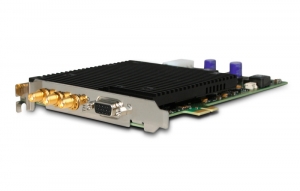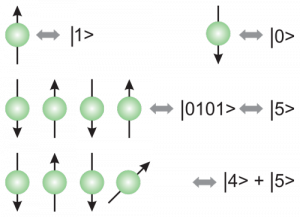There are several methods used in the development of the necessary building blocks of a quantum computer. The study and the functionality test of these blocks is then very often performed via coincidence correlation methods or timing analysis of photon detector signals in order to prove the general working pricingple of the building block under study.
PicoQuant offers several instruments such as time-tagging units and single photon sensitive detectors that can be used to perform coincidence correlation or timing analysis:
 MultiHarp 150
MultiHarp 150
High-Throughput Multichannel Event Timer & TCSPC Unit
- 4, 8, or 16 independent input channels and common sync channel (up to 1.2 GHz)
- High sustained data throughput (80 Mcps in time tagging mode, 180 Mcps in histogramming mode)
- Record-breaking dead time (650 ps) per channel
- No dead time across channels
 HydraHarp 400
HydraHarp 400
Multichannel Picosecond Event Timer & TCSPC Module
- Up to 8 independent input channels and common synch channel (up to 150 MHz)
- Time channel width of 1 ps
- Time tagging with sustained count rates up to 40 Mcps
- USB 3.0 connection
 PicoHarp 330
PicoHarp 330
Precise and Versatile Event Timer & TCSPC Unit
- Outstanding timing precision of 2 ps RMS for single channel, 3 ps RMS between channels
- Cutting-edge time resolution of 1 ps
- Choice of edge triggers or Constant Fraction Discriminators (CFD)
- Sustained time tagging with up to 85 Mcps via USB 3.0
tion
 TimeHarp 260
TimeHarp 260
TCSPC and MCS Board with PCIe Interface
- One or two independent input channels and common synch channel (up to 84 MHz)
- Two models with either 25 ps (PICO model) or 1 ns (NANO model) base resolution
- Ultra short dead time (< 25 ns for PICO model, < 1 ns for NANO model)
- PCIe interface
 PDM Series
PDM Series
Single Photon Avalanche Diodes
- Timing resolution down to < 50 ps (FWHM)
- Detection efficiency up to 49%
- Different active areas: 20, 50, and 100 µm
- Ultra stable at high count rates
QuCoa
Quantum Correlation Analysis Software
- Antibunching (g(2)) measurements including fitting to several models
- Coincidence counting / event filtering, using AND, OR, NOT operators
- Preview of antibunching curve and correlation data during measurement
- Remote control via TCP/IP Interface
The following presentations are related to quantum information processing and were recorded at our International Symposium on "Single Photon based Quantum Technologies" in September 2020.
Latest 10 publications related to Quantum Information Processing
The following list is an extract of 10 recent publications from our bibliography that either bear reference or are releated to this application and our products in some way. Do you miss your publication? If yes, we will be happy to include it in our bibliography. Please send an e-mail to info@picoquant.com containing the appropriate citation. Thank you very much in advance for your kind co-operation.



 Contact us
Contact us MultiHarp 150
MultiHarp 150 HydraHarp 400
HydraHarp 400 PicoHarp 330
PicoHarp 330 TimeHarp 260
TimeHarp 260 PDM Series
PDM Series
